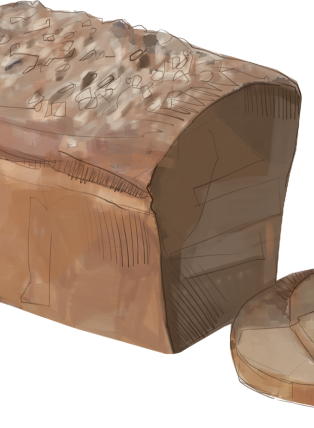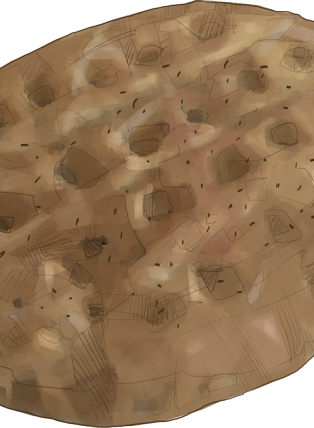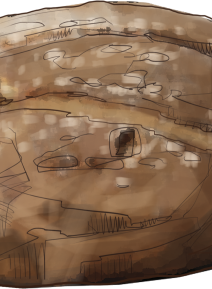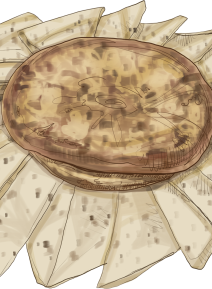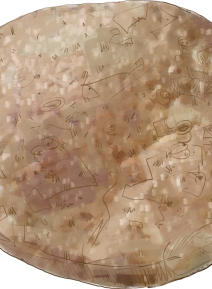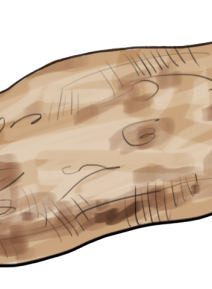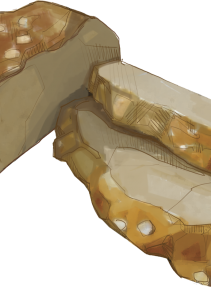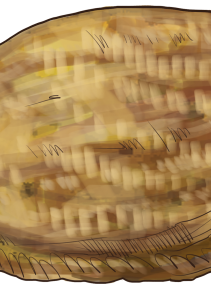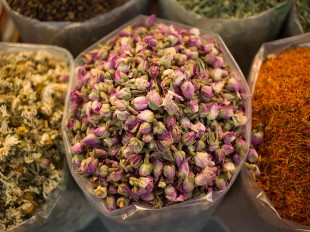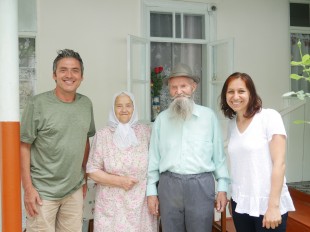It is a must on our tables and impossible to imagine them without. Its smell and taste hypnotize us. Bread has been a symbol of abundance and prosperity for centuries. Our friendships begin with eating bread together and when we swear, we swear by bread. Particularly for Muslims, having bread on the table means that all the necessary blessings are present. A hadith about the Prophet Muhammad reads: If bread and meat are brought to the table for you, first take the bread and take away your hunger with it, and then eat the meat. Bread is always served first because it is the king of the table. It is the greatest sin to disregard it, throw it away or under your feet, or break it over your knee.
The history of bread is assumed to go back thousands of years. In the Stone Age our ancestors ate raw wheat, then learnt to grind it between stones and millstones, mixing the resulting flour with water to make thin porridge. The ancient Egyptians are considered the first bakers, having noticed how adding old dough to the mixture made the dough rise. Later the ancient Greeks also became master bakers.
is the greatest sin to disregard it , throw it away or under your feet , or break it over your knee
Bread has a very special status in Azerbaijan. On 20 October 2016 International Chefs Day saw the Bread Festival held for the first time in Baku. 24 cities and regions of Azerbaijan were represented through exhibitions of bread and bakery products and handcrafts, organised according to geographical zones and regions. Bread is so sacred for us that if we see a piece of bread which has fallen on the ground we take it immediately, kiss it and put it on our eyes. Azerbaijanis who find themselves in difficult situations swear by bread, asking God not to deprive them of it, and they meet the most respected guests with bread and salt, a symbol of loyalty, honesty, peace and solidarity. Our ancestors didn’t use the saying Bread and salt is honest bread for nothing; they meant that where you have “honest bread” there shouldn’t be any betrayal. They also said that there would never be abundance in the home of someone who disregards or disrespects bread, because to do so removes the blessing from the home.
In Azerbaijan there are many traditions and customs related to bread. For example, three days before a wedding, older and younger married women gather and go to the bride or groom’s house to bake bread (chorakbishirdi). They knead the dough, cut it into pieces, roll it out and bake lavash. The first baked bread is given to the mothers of the bride and groom. They say: May your table be blessed and your bread hot. In many villages in Azerbaijan on wedding days a loaf of bread should be divided between the bride and groom’s relatives. People believe that those who get the bigger pieces will have greater abundance. Besides, when the bride leaves her father’s house, cutting a loaf of bread over her head is thought to attract abundance.
There are various sayings, aphorisms, bayati (folk poems) and even curses in Azerbaijani folklore related to bread, for example: You shouldn’t step on bread, A piece of bread may help you over the mountain and His bread is on his knees.
Forgotten types of bread
Various types of bread are baked in the country, some of which have a history going back thousands of years and are almost forgotten. Examples of breads baked in Azerbaijan are yukha, yayma, fatir, lavash, sangak, khamrali, fasali, kata, tandir, khorakli, bayim, Lezgin bread and others.
Bread is so sacred for us that if we see a piece of bread which has fallen on the ground we take it immediately , kiss it and put it on our eyes
Tandir bread and lavash which is prepared on a saj (iron plate) are the most commonly baked types of bread. Tandir is famous for its taste and smell and has a particular method of preparation in many regions of Azerbaijan. In order to prepare tandir bread the dough should be kneaded and left for fermentation. Once fermented it is cut into smaller pieces which should have an oval or circular shape and be decorated with various patterns. Before baking, the bread should be greased with egg yoke or ayran and sometimes with saffron. The smell of bread taken from the tandir oven creates a good mood, gathering people together and dispelling sadness and sorrow. Tandir bread is so delicious that people eat it on its own, piping hot, although it can also be prepared and stored for a long period of time.
Although today various technologies are used to bake bread the tradition of baking in the tandir oven, passed down from generation to generation, still persists. Centuries have passed but these tandir ovens haven’t changed, remaining just as they were in ancient times: archaeological excavations in various parts of Icheri Sheher (Baku’s Inner City) found a large number of tandir ovens belonging to the Middle Ages. Today tandirs are still used in Baku as well as rural villages; some families even build tandir ovens in their yards to bake bread at home and eat it piping hot.
A regional affair
There are types of bread and baking methods specific to certain regions of Azerbaijan. These types of bread have different tastes as well. For example, people in the Nakhchivan, Qubadli and Zengilan regions mostly bake lavash. In these regions lavash is prepared in reserve for two to three months, then dried and wrapped in fabric and kept for long periods. In the past this longevity meant that soldiers, travellers and shepherds would take lavash on long journeys. Before eating, they would sprinkle some water to soften the wrap, which they would then fill with cheese, cream or oil and eat comfortably seated on horseback. Azerbaijani housewives consider it important to make lavash so thin that it is almost transparent, although the actual shape and consistency varies from region to region. For example, lavash made in Nakhchivan is thicker, circular or oblong and is baked in the oven.
One of the bread types which is widespread in Baku, Ganja, Nakhchivan and Shamakha in the past was sangak. This type of bread is baked in an oven made from red bricks, on small stones, and is mainly used for soups and fatty dishes like piti and bozbash. Its main advantage is that it stays fresh for three to four days and is easily digested. Therefore it is also often recommended for people suffering from gastrointestinal diseases.
Zeyran belongs to the southern part of Azerbaijan and is mainly baked in Lenkeran. Those who try it once, with its specific smell and look, will want to taste it again.
Lezgin bread resembles the sun in appearance and this relates to the mythology of the Lezgin people, who live mainly in Qusar. One of the breads they bake is kharak, named after the special tandir ovens made from earth, which are unique to the northern regions of Azerbaijan. This bread, made from dough with water, salt and yeast, can be kept for a long time without going mouldy: for seven days at normal room temperature and 15 to 20 days in the fridge. The dough is then divided into parts and rolled out. Before Lezgin bread is placed in the kharak, the baker punctures it with a special instrument fashioned from turkey or rooster feathers, which facilitates the baking process by allowing in hot air and also adds decoration to the bread. It is usually ready in five minutes but sometimes the bread is taken out early, greased with cheese and butter and put back in the kharak for a few more minutes. The result is known as Lezgin pizza.
Along with bread, many other Lezgin pastries are baked in the kharak, as well as afar - Lezgin qutabs. The dough is rolled out very thinly and various herbs and greens, collected from the mountains or the yard, are chopped and mixed with cheese and laid out on the rolled dough. This is then covered with a second layer of flat, thin dough and baked in the kharak.
Bread museum
Since the first bread museum was established in Zurich in 1940, many others have opened around the world, including in Azerbaijan. Unfortunately, however, the Museum of Bread in Aghdam, like much of this once blossoming town, was destroyed during the Karabakh War and remains in the Armenian-occupied zone of Nagorno-Karabakh. Housed in a mill adorned with Soviet-era mozaics, it opened its doors in 1983 and quickly became a symbol of the town. Its exhibits included fossilized wheat samples, ancient farming tools, examples of regional types of bead, manual and mechanized mills, a 1930s Trier machine and a scorched piece of bread from the Siege of Leningrad (1941-1944).
People believe that those who get the bigger pieces will have greater abundance
Besides Azerbaijani writers, poets, and scholars, foreign intellectuals have also expressed various thoughts about bread. The famous Russian scientist A.K.Timirzayev once said: Bread is the greatest invention of the human mind. So respecting this invention is our holy duty. If there is bread, there is laughter, song and dance. A nation that has bread will never fall or die. As our great poet Samed Vurgun once put it very well:
No seed should fall on the ground for no reason,
If there is plenty of bread, the Motherland is
unconquerable!
About the author: Gunel Manafli is a Baku-based journalist originally from Sheki.